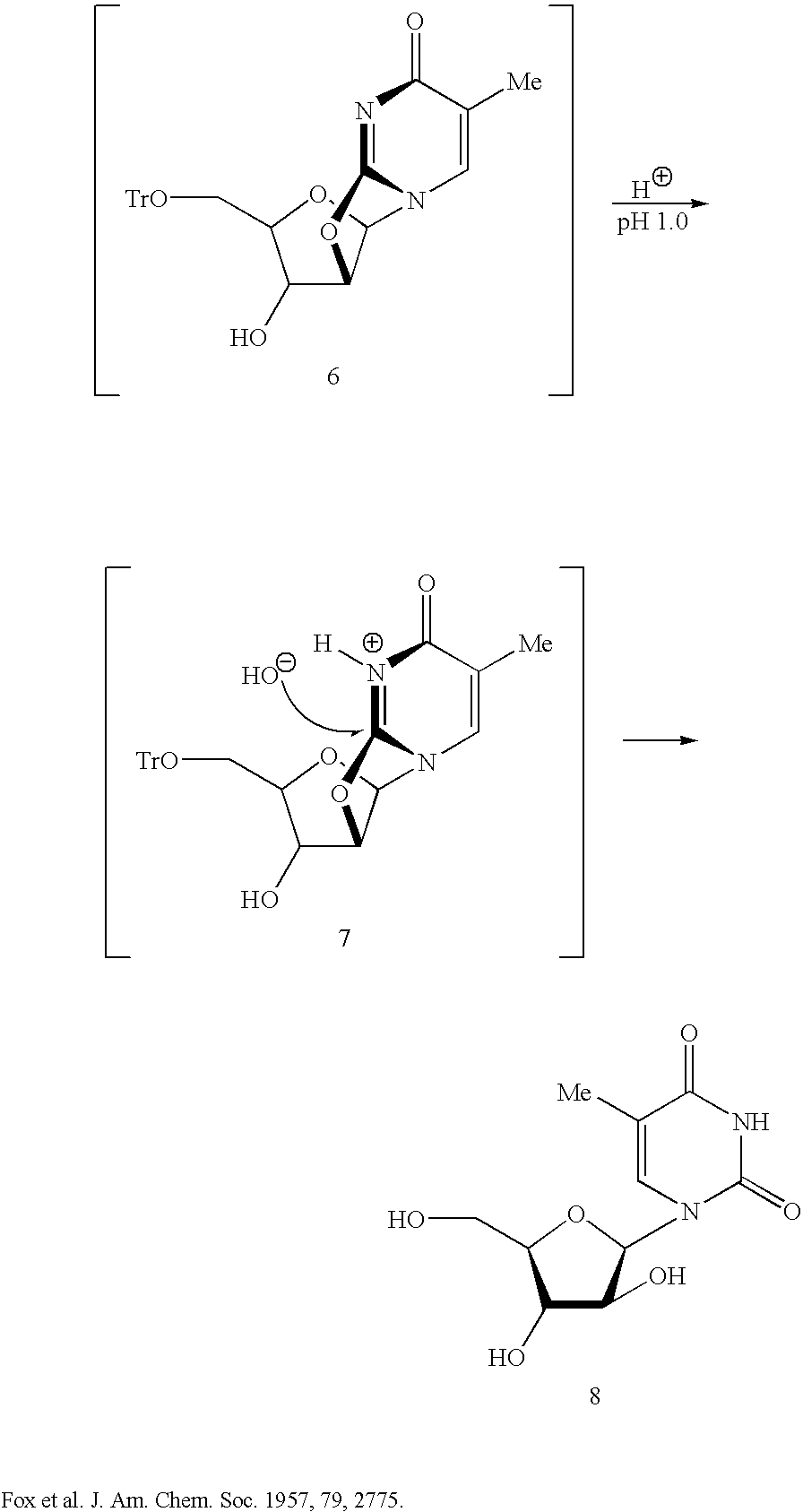Biocatalytic synthesis of aminodeoxy purine N9-beta-D-nucleosides containing 3-amino-3-deoxy-beta-D-ribofuranose, 3-amino-2,3-dideoxy-beta-D-ribofuranose, and 2-amino-2-deoxy-beta-D-ribofuranose as sugar moieties
a technology of aminodeoxy purine and n9-beta-d-ribofuranose, which is applied in the direction of sugar derivatives, organic chemistry, fermentation, etc., can solve the problems of remained rather laborious and expensive tetraisopropyldisiloxyl group, and the drawback of arabinoside 20-22
- Summary
- Abstract
- Description
- Claims
- Application Information
AI Technical Summary
Problems solved by technology
Method used
Image
Examples
example 1
Synthesis 3′-amino-3′-deoxythymidine (3′NH2-dThd)
[0063]
[0064] To a stirred solution of AZT (100 g, 0.374 mol) in a mixture of THF (850 mL) and water (20 mL) at 40-50° C. was added dropwise during 3 h a solution of Ph3P (106 g, 0.404 mol; molar ratio is 1.0:1.08) in THF (300 mL) and the reaction mixture was stirred for 24 h. Thin crystalline product formed was filtered off, washed with THF (250 mL) and dried on air for 48 h to give 79 g (87.5%) of TLC pure 3′NH2-dThd.
[0065] Combined mother liquor and washing were evaporated to dryness to give 128 g of a mixture that was partitioned between water (300 mL) and CH2Cl2 (700 mL), water phase was evaporated to give 3′NH2-dThd as a main component along with Ph3PO (14 g). It was crystallized from a mixture of EtOH (140 mL), MeOH (120 mL) and water (8 mL) under reflux, followed by cooling at +4° C. during a week gave, after filtration of thin crystalline product and washing with abs. ETOH (2×20 mL), CH2Cl2 (2×20 mL), and ether (2×20 mL), 9....
example 2
Synthesis 3′-amino-2′,3′-dideoxyadenosine (3′NH2-ddAdo)
[0066]
[0067] A reaction mixture (100 mL) containing 3′NH2-dThd (2.42 g, 0.01 mol), adenine (0.68 g, 0.005 mol), potassium phosphate buffer (20 mM, pH 6.0) and biocatalyst (E. coli cells 1K / 1T or glutaraldehyde (GA) treated cells E. coli cells 1K / 1T; 3.0 g wet weight; 0.6 g dry weight) or pure thymidine phosphorylase (1250 IU) with purine nucleoside phosphorylase (950 IU) was incubated at 50° C. with gentle stirring for 16-24 h, cooled down till room temperature and placed into a refrigerator at 4° C. for 24 h. The biocatalyst was separated by centrifugation (5,000×g; 10 min), treated with water (20 mL) at room temperature and again centrifuged under the same conditions. The supernatants were combined and applied onto a column (3.0×5.7 cm; 40 mL) with Dowex 1×8 (200-400 mesh, OH−-form). The column was eluted with water; the product containing fractions were combined (ca. 150 mL), evaporated at 50° C. to dryness and co-evaporated...
example 3
Synthesis 2-amino-(3-amino-2,3-dideoxy-β-D-ribofuranosyl)adenine (3′NH2-ddDAP) and 3′-amino-2′,3′-dideoxyguanosine (3′NH2-ddGuo)
[0068]
[0069] A reaction mixture (100 mL) containing 3′NH2-dThd (2.42 g, 0.01 mol), 2,6-diaminopurine (0.75 g, 0.005 mol), potassium phosphate buffer (20 mM, pH 6.0) and biocatalyst (E. coli cells 1K / 1T or glutaraldehyde (GA) treated cells E. coli cells 1K / 1T; 3.0 g wet weight; 0.6 g dry weight) or pure thymidine phosphorylase (1250 IU) with purine nucleoside phosphorylase (950 IU), was incubated at 50° C. with gentle stirring for 16-24 h, cooled down till room temperature and placed into a refrigerator at 4° C. for 24 h. The biocatalyst was separated by centrifugation (5,000×g; 10 min), treated with water (20 mL) at room temperature and again centrifuged under the same conditions. The supernatants were combined and applied onto a column (3.0×5.7 cm; 40 mL) with Dowex 1×8 (200-400 mesh; OH−-form). The column was eluted with water; the product containing fra...
PUM
| Property | Measurement | Unit |
|---|---|---|
| temperature | aaaaa | aaaaa |
| temperature | aaaaa | aaaaa |
| temperature | aaaaa | aaaaa |
Abstract
Description
Claims
Application Information
 Login to View More
Login to View More - R&D
- Intellectual Property
- Life Sciences
- Materials
- Tech Scout
- Unparalleled Data Quality
- Higher Quality Content
- 60% Fewer Hallucinations
Browse by: Latest US Patents, China's latest patents, Technical Efficacy Thesaurus, Application Domain, Technology Topic, Popular Technical Reports.
© 2025 PatSnap. All rights reserved.Legal|Privacy policy|Modern Slavery Act Transparency Statement|Sitemap|About US| Contact US: help@patsnap.com



